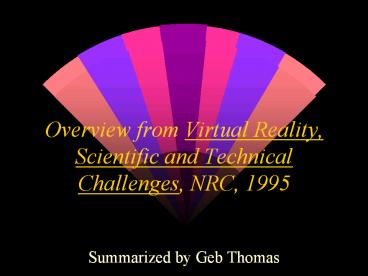Overview from Virtual Reality, Scientific and Technical Challenges, NRC, 1995 - PowerPoint PPT Presentation
Title:
Overview from Virtual Reality, Scientific and Technical Challenges, NRC, 1995
Description:
Overview from Virtual Reality, Scientific and Technical Challenges, NRC, 1995 Summarized by Geb Thomas Learning Objectives Be able to describe the current areas of ... – PowerPoint PPT presentation
Number of Views:176
Avg rating:3.0/5.0
Title: Overview from Virtual Reality, Scientific and Technical Challenges, NRC, 1995
1
Overview from Virtual Reality, Scientific and
Technical Challenges, NRC, 1995
- Summarized by Geb Thomas
2
Learning Objectives
- Be able to describe the current areas of research
related to SE. - Be able to draw a system diagram differentiation
teleoperation and virtual environments. - Be able to define augmented reality.
- Be able to distinguish the NRC definition of
Presence from Ellis definition. - Define the distinctions between a simulator and a
virtual environment. - Describe common characteristics of SEs.
- Define the symptoms of sopite syndrome.
3
Introduction
- Includes both Virtual Environments and
Teleoperation - VE - Human connects to simulated world
- Telerobotics - Human connects to a real world via
a robot sensors and actuators
4
Scope of the SE Field
- Multidisciplinary
- Terminology confusion
- input and output
- interface
- High talk-to-work and excitement-to-accomplishment
ratios
5
Current Areas of Research
- Computer generation of VE
- Design of telerobots
- Improvement of human/machine interfaces
- Relevant aspects of human behavior
- Comm. systems and networks
- Computer-generated images of the real world
6
Basic Concepts and Terminology
- Teleoperator system -- a human operator, a
human-machine interface and a telerobot - facilitate the human operators ability to sense,
maneuver in, and manipulate the environment - Virtual environments system -- a human operator,
a human-machine interface and a computer
7
(No Transcript)
8
Augmented Reality System
- Virtual and real environments are combined
- Information from real environment is directly
sensed with see-through display, supplementary
information from VE is overlaid on the display - VE, Teleoperator and Augmented Reality together
constitute Synthetic Environments
9
(No Transcript)
10
Presence
- Telepresence, virtual presence or synthetic
presence - Extent to which the human operator loses his or
her awareness of being present at the site of the
interface and instead feels present in the
artificial environment - Depends on transparency of interface, amount
and kind of interaction
11
VE and Simulator Distinction
- VEs are
- Reconfigurable
- Can create unnatural environments
- Highly interactive and adaptable
- Variety of sensing modalities
- Strong sense of presence
- Simulator is tied to physical system, VE to the
operator - Simulator does far field, VE does near field
12
Common Characteristics
- Visual and auditory displays
- Head-mounted display monitoring head position
- Control signals from head, hands, feet or speech
- Haptic interface - interfaces hand for manual
sensing and manipulation with gloves or
exoskeletons
13
Application Domains
- Entertainment
- National Defense
- Design, Manufacturing, and Marketing
- Medicine and Health Care
- Hazardous Operations
- Education
- Information Visualization
- Telecommunication and Teletravel
14
Some Psych. Considerations
- Most human behavior topics are relevant
- Human performance
- Sensorimotor resolution
- Perceptual illusions
- Information transfer rates
- Manual tracking
15
Sopite syndrome (simulator sickness)
- Symptoms
- chronic fatigue,
- lethargy
- drowsiness
- nausea
- Causes --
- Temperature
- Field of view
- Visual/kinesthetic misalignment
- Interaction effects
16
Current State of Technology
- Visual channel
- Auditory channel
- Position tracking and mapping
- Haptic channel
- Motion interfaces
- Other interfaces
17
Visual channel
- Poor resolution
- Limited field of view
- Excessive weight
- Poor fit
- May cause sopite syndrome
- 10K-1M
- Stereo glasses, booms
18
Auditory Channel
- Effective, inexpensive and ergonomically
reasonable - Limited spatial resolution
- Loud speakers are sensitive to head position
- Record and playback technologies must store huge
quantities of information - Auditory scene analysis requires central
processing
19
Position Tracking and Mapping
- Position tracking
- Real-time measurement of pose
- Position mapping
- Dense set of 3D positions on a surface
- Determine body dimensions
- Facial expressions
- map real environments
20
Position tracking
- Mechanical linkages
- Magnetic sensors
- optical sensors
- acoustic sensors
21
Haptic channel
- Complex combination of sensory functions and
manipulative functions and electromechanical
systems - Lack of recognized social need
- Body-based gloves and exoskeletons
- Ground-based devices (joysticks, robots)
- Tool-handle systems
- Skin, tactile displays
22
Motion interfaces
- Vestibular system,
- Motor system,
- Visual and auditory systems,
- Proprioceptive/kinesthetic systems
- Tactile systems
- Inertial Displays -- body moves
- Noninertial displays -- body remains stationary
- Treadmills, stair climbers, stationary bikes
23
Telerobotics
- Design and performance of robots
- micromechanical systems
- Communication time delays
- 30 ms between Washington and LA
- 1 s between Earth and Moon
- Supervisory control and predictive displays
- Demands of real time input/output
- distributed telerobotics
24
Networks
- Shared virtual environments
- SIMNET
- 300 soldiers in tank and aircraft simulators
interacting - 10baseT standard
- 100baseT optional at CoE
- 1.25 Gbit/s reasonable, with effort
25
Recommendations
- Promising application areas
- Design, manufacturing and marketing
- Medicine and health care
- Hazardous operations
- Training
- Two special projects
- Modeling the human body
- Knowledge transfer
26
Learning Objectives
- Be able to describe the current areas of research
related to SE. - Be able to draw a system diagram differentiating
teleoperation and virtual environments. - Be able to define augmented reality.
- Be able to distinguish the NRC definition of
Presence from Ellis definition. - Be able to define the distinctions between a
simulator and a virtual environment. - Be able to describe common characteristics of
SEs. - Be able to define the symptoms of sopite syndrome.
27
(No Transcript)































